The North Coast is dynamic.
Where else can a person say "the cliffs come and the cliffs go"?
The diving is great year after year.
There are a number of dangers out there, but here it is fear that can actually get you killed.
The Russian Fort at Fort Ross is worth seeing on its own. It is an amazing, rough hewn wooden
structure that vividly brings to mind the not only the historic Russian presence on the coast,
but the roughness of the land and the time. The diving around it is great though... when it's
not to rough.
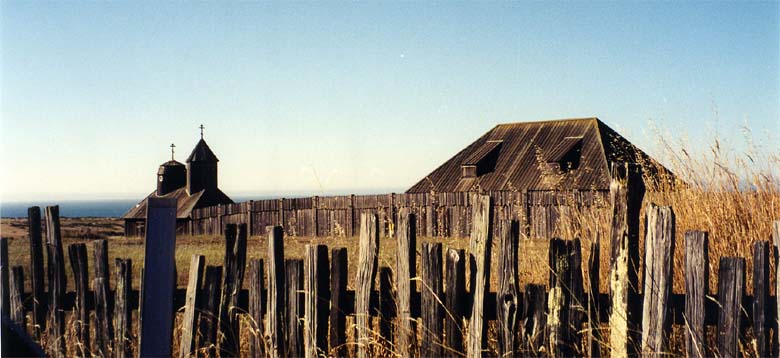
I'll bet it got muddy in there in winter.
The shortest way to the North Coast diving is to cross from highway 101 in Santa Rosa across River Road, following the Russian River to Jenner at Highway 1 on the Coast. Most of the best diving is north from there. You start up the hill called the Dramamine Highway and about 5 miles later the road gets a lot less windy and steep. It's about 12 miles to Salt Point State Park and Gerstle Cove Reserve. Traditionally, most divers have stopped there because the abalone diving there has been excellent for years as well as that it is some of the best coastal access there is. Now divers tend to go further for a couple of reasons, but it used to be that most divers just didn't go as far as Fort Ross. Now a distinction should be made. There is the main protected cove at Fort Ross which was the reason the Russians built a fort there. It has had a fair number of divers, but north of that is a large cove known as Clam Beach. The cove is about a mile across with a point on each side. This is where I did a lot of diving. The most convenient place to access it is towards the north side of the cove where the road goes nearest the shore. There are some trees there and you can identify the spot by the stairs that go up and over the fence there. You can also tell the spot because there is usually a few cars parked there where the trees start on the north side of the field. It is about 180 yards to the northern point there and there are a lot of large offshore rocks. It is about 1000 yards to the more interesting areas on the south side of the cove. I usually go to the south side because it is more protected. Really, you can dive anywhere in the cove that you can get to. It's just a bit longer swim in the middle of the cove.
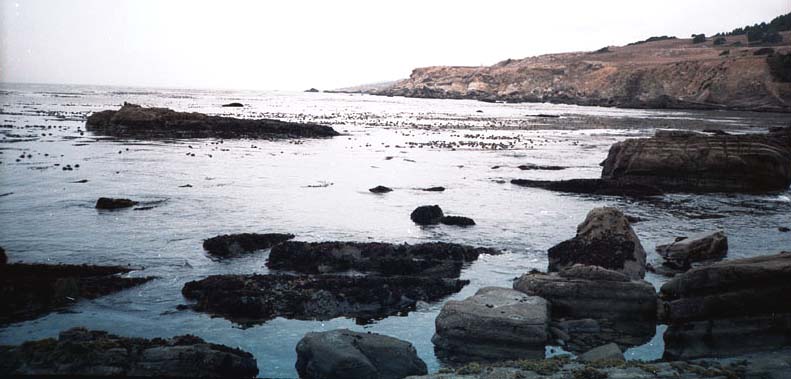
This is a huge dive area from just offshore to as far as you want to swim.
The hike to the shore is part of the fun. There are often cows there in the fields. They seem friendly enough though I never worked hard to make their acquaintance. There are rabbits as well as a lot of red tailed hawks and I have watched turkey vultures soaring in the ocean breeze 20 feet over my head. This is a cow field near the road, but it is still a somewhat wild place. It is all quite beautiful. Pick your route across the fields to avoid low areas. They can get marshy and very muddy. If it is Spring when there is a lot of water, it can be hard to cross in places. Follow the small trails. Then you have to get down the cliff. That's another reason to dive the points. It's easier to get down there. The difficulty of getting down changes over time. The first time I was there, there were a number of trails down the cliffs. Year by year it got steeper and harder to get down, until one El Nino year when all the cliffs got smashed by the storms and getting down the cliff was relatively easy. Year after year after that, the cliffs got steeper again. It is a great place to use one of the backpack floats that you can put your gear in for the hike. As you go down the cliffs you see interesting succulents finding a living in the rocks.
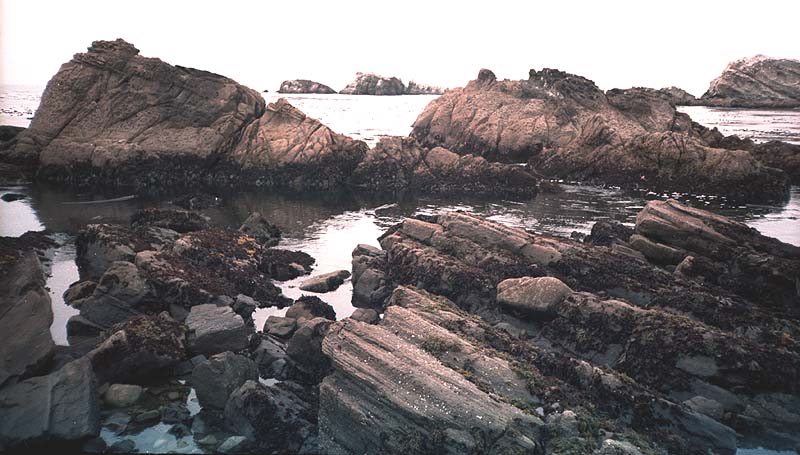
This is the shape of the bottom. Boulders, shelves, cracks and holes, but all full of life underwater.
A lot of divers use a poncho made of two towels sewn together for changing before and after a dive. It can keep you warm when the sea breeze blows. Once you make it down the cliff, follow standard rock shore entry procedures. Put fins on at the waters edge, get in and swim fast to get past the waves. All the diving is good. Anywhere in the cove has the potential to produce a nice sized abalone or a personal adventure. If it is low tide you have to cross a lot of rocks to get to the water, especially in the center of the cove. The north side of the cove is more dramatic with big rocks sticking up, but I figured the south side was further and so fewer divers would walk all the way there. It is fascinating in that there is a ridge of reef that goes off at one point for more than 100 yards with very shallow water only about 4 feet deep at a mid tide. In one place about 75 yards out, the rocks extend above the surface. It's to shallow for most divers to be comfortable on because of the wave and surge action pick up there and can make the place vibrate with moving water. Of course it's where I go if it's nearly calm enough. I was there with my friend Dan on a particularly calm day and some divers were slowly moving along the shore in an inflatable and making occasional dives. I told Dan to watch when they got close, that they would start moving fast because they would be uncomfortable in the shallow moving water. Sure enough, they went across the shallow spot much faster than they had been moving along. It was also that day that it was calm enough that I was able to dive in just a couple of feet of water in an area that is usually just to rough to dive. It is actually a small area right below the low tide , behind a rock, but still in the real waves. I actually hunted there near shore, something I almost never do, but it was a small area that rarely gets divers and I found some nice sized abalone.
One way to dive here is to get down along side rocks where the kelp has been worn off the rock by water movement. It makes a nice passage for a diver. Try to get to the bottom and find shelves underneath the kelp growth. Lay down on the bottom next to them and look in to find hidden life. Free diving lends itself to moving along through the kelp and rocks such that a lot of times you can surprise a fish when you come upon them. It's not like scuba where they heard you already and have decided to stay or go. They are surprised at your intrusion, but you are gone before they can really react.
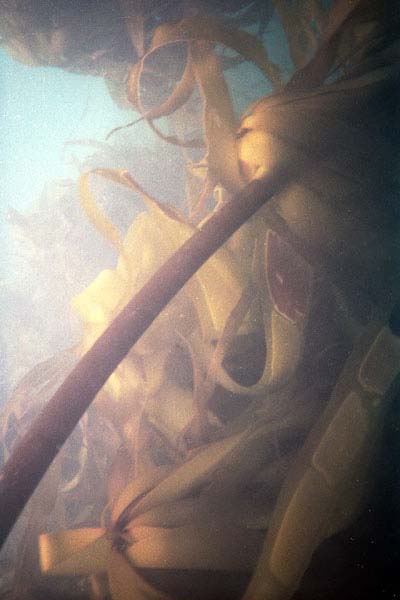
One of my early UW photography attempts. The kelp is like a wall, but there are paths through it.
Sometimes I would go there and take a long time getting abalone while looking around. I could swim to an offshore rock, explore around it, climb on it and claim it for the people of the world that love natural beauty. Other trips I would spend a long time swimming around exploring and not really hunting at all. Sometimes I would see big ling cods or cabazon. I almost always saw various perch and rock-fish. There were a lot of invertebrates I couldn't identify and things that I still wonder if they were natural or from some ship perhaps 200 years ago that visited the coast for lumber or cattle. Some of the best diving could be in tide pools of various sizes and depths that were actually inside of the surf. You could find deep shelves in some. The shallow clear waters show off the life in brilliant colors. It was just a natural playground that I came back to over and over.
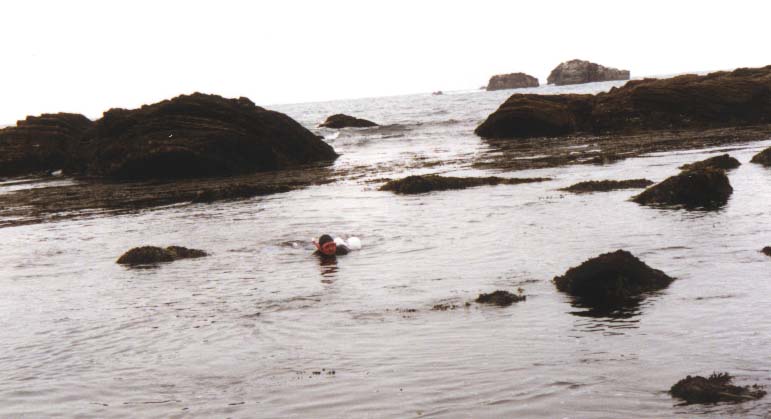
Notice my high-tech one gallon water jug dive floats there for my abalone bag. It is minimalist
diving and you have to be prepared to bail out up there. If that means ditching a bag, so be it.
I love it when I swim into the calm tide pools like that.
Lest we forget that this is the North Coast. I went there on a number of occasions when the winds and seas precluded any chance to do a sane dive. Then you must just enjoy the rugged scenery, but that's OK.
Another one of my early UW photography attempts.
There was the trip I made with my sister's family. We drove from San Jose straight to Fort Ross. It was a rough enough day to make diving marginal. It was a time when the cliffs were steep and Mohan was a life saver helping me get myself and gear down the cliff. No one else tried to go down. I had fun. I got my limit of abalone, but it was not a time to dawdle in that water.
After spending the night in Santa Rosa, we went back the next day. I was hoping the waves had calmed down some. A little after we passed the Korbel winery we got to Jenner and I could see the sand bar at the Russian River mouth. A clean 5 foot wave was breaking on it. It was not tipping, it was throwing out and pounding as it hit the shore. Not a good sign. These were probably storm waves with serious punch in them.
When we got to Fort Ross, it looked very lively, much rougher than even yesterday. We parked at Clam Beach and I went to the cliff to look for a spot I could dive. The cove is about a half mile wide. There may be a bit of beach under the cliff, but the water entry is all boulder. At the south end was a possibility where the cove turned into Fort Ross Cove. It made it a little calmer, but still pretty big. Below the point, on the north side of the cove, about 100 yards out was a spot with some truck sized rocks making a barrier about 80 feet wide. It had big waves around it, but there was a slightly protected spot, maybe 60 feet wide inside of it. I watched for a while debating if I should try it. I really wanted to hunt, but it was nasty out there with fairly constant waves that got very big occasionally.
I was there for a while when I saw two divers go in to the spot below the north point. While I rarely buddy dive, I have no objection to them and buddy diving seemed like a real good idea just now. I figure that they can tell the Coast Guard which direction the current took me. I ran across the cove and then down the cliff to follow them. The entry was a small sort of cove between two areas of rocks sticking up. It was really rough in the rocks, but calmer in the deeper water between them. I got in and it was easy to ride the water flowing out the middle of the cove to where the two divers were. It was rough all around the area we were diving in. I had carefully looked over the area from the cliff and knew just how wide the area was that didn't break when the big sets came in. It got real nasty all around that area though. Each time I made a dive, I came up and checked that I was still near enough to get into the safe spot if it picked up. On one dive, I grabbed two big abs that were together. The other divers just wanted to get their ab limit and get back out. Then, as always happens, there was a big set. I moved in fast. The calm spot got down to about a 40 foot wide foamy patch with big waves breaking all around us. We moved to the center until we were about 15 feet apart. No diving now. Just watching what is happening around you to see if you are suddenly in trouble. You just stay put and perhaps hold on to some kelp to make sure that no current has you. When that happens, rationally you know that it's going to calm down again and things will be OK. What you feel is another thing. The danger is that if you give in to fear any, it will tire you out and you will be in trouble. As soon as it calmed some, the other divers headed to shore. I wanted to fill my limit with a couple big ones, so I stayed. I found a couple more fatties in just a few dives, which was good, as the next big set came in within just a few minutes and I had to stay relaxed and wait it out again, watching the kelp to make sure I was not caught in a current as 8 foot breakers surrounded the small spot I was hiding in. As soon as it let up, I headed in. Well, all that water that came to shore and over the rocks with the big waves is now trying to find a way back out. It's all coming out that small cove between the rocks that I rode out here in. It is sort of a permanent rip current. The divers on shore were nice enough. They were packed, but they stayed to watch out for me. I found myself in the rip current, but knew to move to the shallow rocks at the side of the cove where there was less current. I had to pull and bounce my way in over the shallow rocks through the waves coming from both the sea and the shore. It's still a lot easier than fighting that rip current. The bag of abalone on my belt worked as something of a bumper against the rocks. I think that maybe the divers on shore were annoyed for some reason. On my part, my method of keeping people watching me comfortable is to swear. As long as I am swearing they seem to figure that I am not panicked. I've done it on more than one occasion. I got to shore. That is a wave tossed me as far as I could go into a tide pool. I laid there relaxing, contemplating if I had gained anything from the experience when one of the divers came over and pulled off my fins. That was nice, but he threw them down in front of me and he never did say hello. What's the difference! He had gone out there too. He just did it with a buddy and got out as fast as he could. No matter what else I say, this is what the North Coast is really about. Not the calm days, but the normal days, the rough days that test a diver.

The booty is part of the fun.
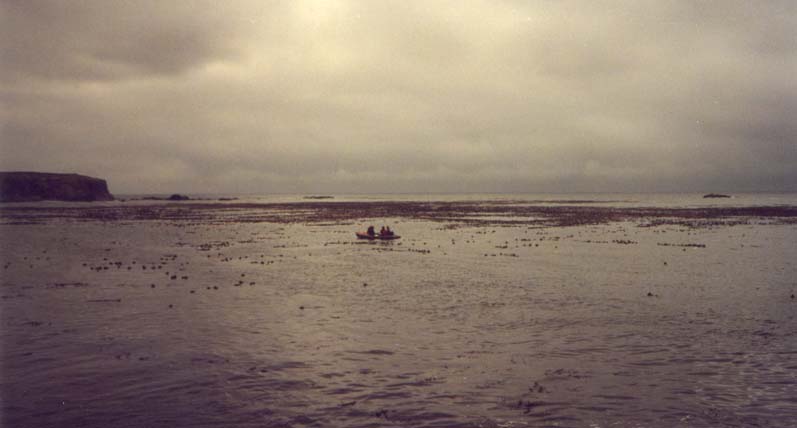
Looking further south from where I hiked south to, shows how much more area there is to dive.
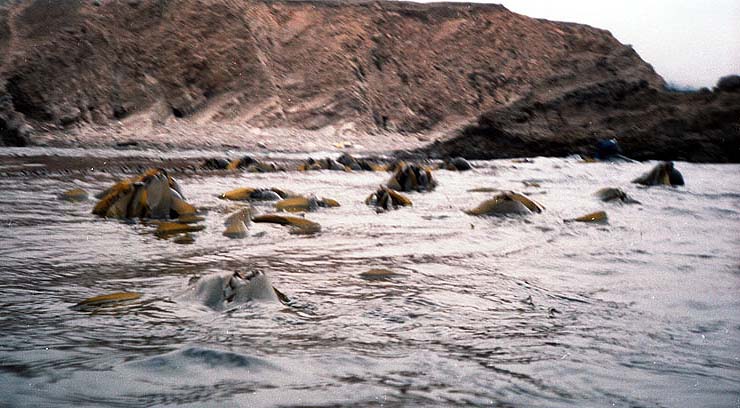
The view I like.
Enjoy The Diving, seahunt